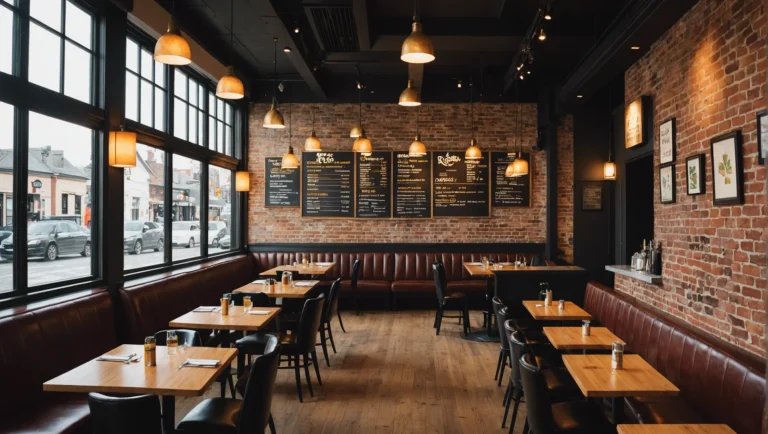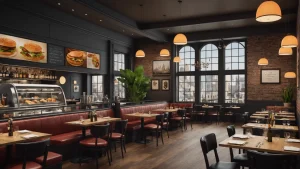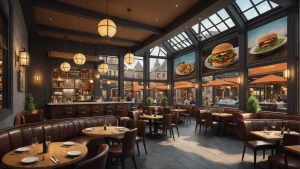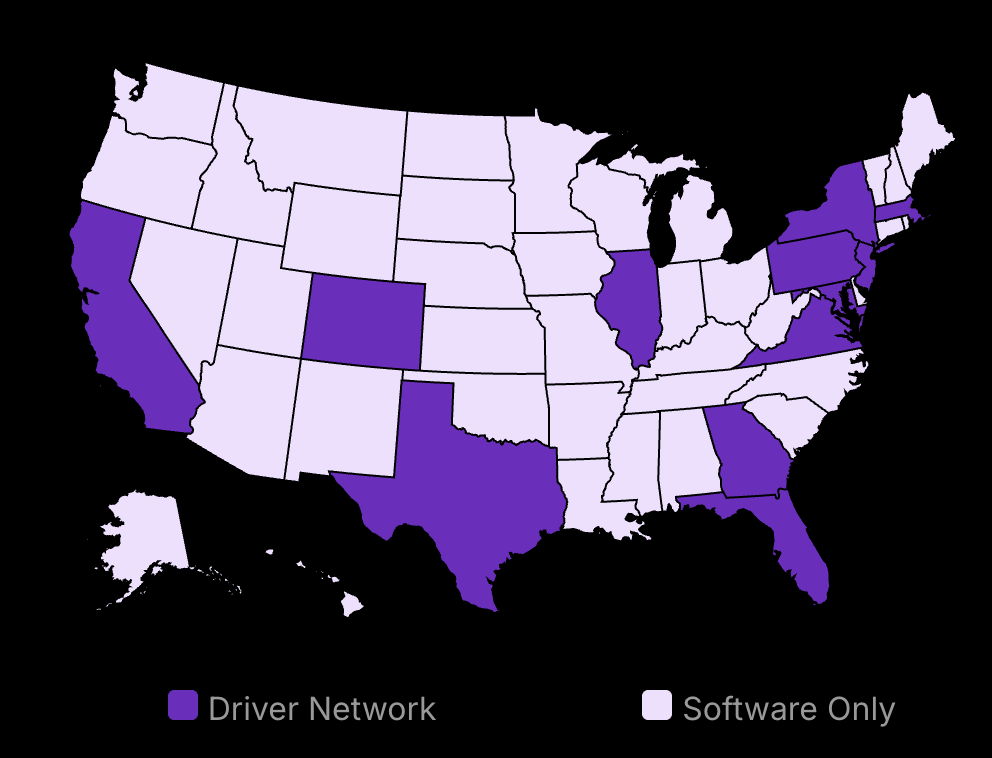Are you tired of watching your restaurant struggle to attract new customers and grow sales? It’s time to take control of your marketing efforts and drive business growth like never before.
In this comprehensive guide, we’ll reveal the most effective local restaurant searches, marketing strategies, advertising ideas, and online promotion tactics that will help you:
Develop a strong brand identity that resonates with your target audience
Leverage social media to engage with customers and showcase your unique offerings
Implement loyalty programs and targeted ads to attract new diners and retain existing ones
Boost your online visibility through SEO, review management, and email marketing
By the end of this article, you’ll clearly understand how to create a compelling restaurant marketing plan that delivers measurable results and drives long-term success. Let’s dive in and discover how to take your restaurant marketing ideas to the next level in 2024!
Online Marketing
Over 1 billion restaurant visits by consumers are influenced by online marketing

Metrobi drivers are rated 4.97 out of 5
Trusted by local businesses for:
- Background-checked professionals
- Specialized in business deliveries
- Same drivers for consistency
- 4.97/5 average delivery rating
Restaurant Marketing Strategies That Drive Business Growth
As a restaurant owner, attracting new customers and retaining existing ones is crucial for the success of your business. By implementing effective marketing strategies, you can increase brand awareness, drive customer engagement, and ultimately boost your bottom line. In this section, we’ll explore three key restaurant marketing strategies that can help you achieve sustainable growth.
Develop a strong brand identity
Developing a strong brand identity is essential for standing out in a competitive market and creating a lasting impression on your target audience. Your brand identity encompasses your restaurant’s unique selling proposition (USP), visual elements, and overall brand story. Elevate your dining establishment’s brand identity with our professional insights on branding strategies, ensuring your restaurant remains memorable and distinct.
Define your restaurant’s unique selling proposition (USP)
You can start by identifying what sets your restaurant apart from the competition. You can consider factors such as your cuisine, atmosphere, service, and pricing. Your USP should be a clear and concise statement that communicates the unique value you offer to your customers.
For example, if you specialize in farm-to-table cuisine, your USP could be, “Experience the freshest, locally sourced ingredients in every dish.” This statement highlights your commitment to using high-quality, seasonal ingredients and appeals to health-conscious diners who value sustainability.
Create a consistent visual identity across all marketing channels
Your visual identity includes your restaurant’s logo, color scheme, typography, and imagery. Ensure that these elements are consistent across all marketing channels, including your website, social media profiles, menu design, and promotional materials.
A consistent visual identity helps build brand recognition and trust among your target audience. When customers see your logo or color scheme, they should immediately associate it with your restaurant and its quality. A reliable logo maker app can help streamline the process, enabling you to create a professional design that aligns with your brand and reinforces recognition across all platforms.
Craft a compelling brand story that resonates with your target audience
Your brand story is the narrative that connects your restaurant with your customers on an emotional level. It should convey your passion, values, and the unique experiences you offer.
To create a compelling brand story, consider the following:
-
Your restaurant’s history and inspiration behind its creation
-
The people behind your restaurant, including the chef, staff, and owners
-
Your commitment to quality, sustainability, or other values that align with your target audience
-
The role your restaurant plays in the local community
Incorporate your brand story into your marketing materials, website, and social media content to create a strong emotional connection with your customers.
Leverage social media marketing
Social media platforms offer a powerful way to engage with your target audience, showcase your offerings, and drive customer loyalty. By establishing a strong presence on relevant social media channels, you can effectively promote your restaurant and attract new customers. Unlock the potential of restaurant social media promotion to boost your online presence, captivate a wider audience, and see your profits soar.
Importance of Social Media
40% of people learn about food through digital methods—websites, blogs, or apps
Establish a strong presence on relevant social media platforms
You can identify the social media platforms that your target audience is most active on. For restaurants, popular platforms include Facebook, Instagram, and Twitter. You can create profiles on these platforms and ensure that your branding is consistent across all channels.
Share engaging content, including mouth-watering food photos and behind-the-scenes videos
Regularly post high-quality, visually appealing content that showcases your restaurant’s offerings and unique atmosphere. You can share mouth-watering photos of your dishes, behind-the-scenes videos of your kitchen staff in action, and updates on new menu items or special events.
When creating social media content, consider the following tips:
Use high-quality images and videos that are well-lit and properly formatted for each platform
Include engaging captions that describe the dish, highlight key ingredients, or tell a story
Use relevant hashtags to increase the visibility of your posts and attract new followers
Post consistently to maintain a strong presence and keep your audience engaged
Encourage User-Generated Content and Interact With Your Followers
Encourage your customers to share their photos and experiences at your restaurant by creating a branded hashtag and featuring user-generated content on your social media profiles. This not only helps to build a sense of community around your restaurant’s brand identity but also serves as social proof for potential customers.
Regularly you should interact with your followers by responding to comments, messages, and reviews in a timely and professional manner. This helps to build trust and loyalty among your customer base and can lead to increased word-of-mouth referrals.
Social Media Marketing
71% of customers say they're more likely to recommend a company that responds quickly to them on social media
Implement a loyalty program
Loyalty programs are an effective way to incentivize repeat visits and encourage higher spending among your existing customers. By rewarding customers for their loyalty, you can create a strong sense of brand affinity and drive long-term growth for your restaurant. Consider leveraging a program for restaurant gift cards to further amplify customer retention, boost your sales, and enrich the dining experience for your patrons.
Design a rewards system that incentivizes repeat visits and higher spending
You can create a loyalty program that rewards customers for their repeat business and encourages them to spend more during each visit. You can consider offering points or credits for each dollar spent, which can be redeemed for discounts, free menu items, or exclusive experiences.
When designing your loyalty program, consider the following factors:
-
The type of rewards that will be most appealing to your target audience
-
The earning and redemption structure of your program (e.g., points per dollar spent, tiered rewards based on spending levels)
-
The ease of use and accessibility of your program for customers
Offer exclusive perks and discounts to loyalty program members
In addition to the standard rewards, consider offering exclusive perks and discounts to your loyalty program members. These could include early access to new menu items, free meals, invitations to special events, or personalized offers based on their preferences and spending habits.
By providing a sense of exclusivity and personalization, you can create a stronger emotional connection with your loyal customers and encourage them to continue choosing your restaurant over the competition.
Utilize a digital loyalty app for a seamless customer experience
To make your loyalty program more accessible and user-friendly, you can consider implementing a digital loyalty app. This allows customers to easily track their points, redeem rewards, and receive personalized offers directly on their mobile devices.
A digital loyalty app also provides valuable data and insights into your customers’ behavior and preferences, which can help you refine your marketing strategies and tailor your offerings to meet their needs better.
By developing a strong brand identity, leveraging social media marketing, and implementing a loyalty program, you can create a comprehensive marketing strategy that drives business growth and sets your restaurant up for long-term success.

Metrobi is transforming catering deliveries
Specialized solutions for catering businesses:
- Catering-trained drivers
- Proper handling equipment
- Peak day delivery support
- 23% average cost reduction
Restaurant Advertising Ideas That Attract New Customers
-
Boost visibility and attract new customers with targeted online ads, influencer partnerships, and local event participation
-
Increase customer engagement and loyalty through social media contests, email marketing campaigns, and referral programs
-
Drive foot traffic and sales with enticing offers, such as limited-time promotions, exclusive menu items, and loyalty rewards
Run Targeted Online Ads
Online advertising is a powerful tool for restaurants looking to attract new customers. Platforms like Google Ads and Facebook Ads allow you to reach your ideal audience based on location, interests, and demographics. To create effective ad campaigns, focus on crafting compelling ad copy and visuals that showcase your restaurant’s unique offerings and entice potential customers to visit.
When setting up your ad campaigns, be sure to target the right keywords and audiences. For example, if you specialize in vegan cuisine, target keywords like “vegan restaurants” and “plant-based dining” to reach people actively searching for these options. Additionally, use eye-catching images or videos of your dishes to grab attention and make your ads stand out.
Partner With Local Influencers and Food Bloggers
Collaborating with local influencers and food bloggers can be an effective way to spread the word about your restaurant and attract new customers. These individuals often have a dedicated following of food enthusiasts who trust their recommendations and are eager to try new dining spots.
To get started, identify influencers and bloggers who align with your restaurant’s brand and target audience. You can look for those who have a strong presence on social media platforms like Instagram, TikTok, and YouTube, and who regularly share content related to food and dining.
Once you’ve found potential partners, reach out to them with a personalized message introducing your restaurant and expressing interest in collaboration. You can invite them to sample your menu and share their experiences with their followers. You can offer complimentary meals, exclusive behind-the-scenes access, or even collaborate on sponsored content or special events.
Participate in local events and festivals
Participating in local events and festivals is a great way to introduce your restaurant to a wider audience and attract new customers. These events often draw large crowds of people looking to explore new food options and support local businesses.
To get involved, research upcoming events and festivals in your area that align with your restaurant’s theme or cuisine. It is better to contact the event organizers to inquire about setting up a booth or food truck to sell your signature dishes. Be sure to prepare enough food to accommodate the expected crowd size and have plenty of promotional materials on hand, such as flyers, business cards, and coupons.
When setting up your booth or food truck, create an eye-catching display that showcases your local restaurant’s brand and menu offerings. You can offer samples of your most popular dishes to entice potential customers and encourage them to visit your restaurant for a full meal. You can also run special promotions or discounts exclusively for event attendees to further incentivize visits to your establishment.
Leverage Social Media Contests and Giveaways
Social media contests and giveaways are an engaging way to attract new customers and increase brand awareness for your restaurant. By offering exciting prizes and encouraging user-generated content, you can create a buzz around your restaurant and incentivize people to visit and share their experiences.
To run a successful social media contest or giveaway, start by setting clear goals and choosing a platform that aligns with your target audience. Popular options include Instagram, Facebook, and Twitter. Determine the type of contest you want to run, such as a photo contest, caption contest, or tag-a-friend giveaway.
Next, you can establish the rules and prize(s) for your contest. Make sure the rules are clear, easy to follow, and comply with the platform’s guidelines. It is better to choose prizes that are relevant to your restaurant and appealing to your target audience, such as a complimentary meal for two, a gift card, or exclusive merchandise.
You can promote your contest or giveaway across your social media channels and encourage your followers to participate by sharing, liking, and tagging friends. You can also partner with local influencers or other businesses to expand your reach and attract new participants.
Social Media Contest Ideas for Restaurants
-
Photo Contest: Encourage customers to share photos of their favorite dishes or dining experiences at your restaurant, using a branded hashtag. Choose a winner based on the creativity, quality, or popularity of the entries.
-
Caption Contest: Post an eye-catching photo of one of your dishes or your restaurant’s interior, and ask followers to submit creative captions. Select the winner with the most entertaining or clever caption.
-
Tag-a-Friend Giveaway: Ask your followers to tag friends they’d like to dine with at your restaurant for a chance to win a complimentary meal or gift card. This helps expose your restaurant to a wider audience and encourages word-of-mouth referrals.
Implement A Customer Referral Program
Word-of-mouth marketing is one of the most powerful tools for attracting new customers to your restaurant. Implementing a customer referral program can help you leverage the power of your existing customer base to drive new business and increase loyalty.
To create an effective referral program, start by deciding on the incentives you’ll offer to both the referring customer and the referred friend. Common incentives include discounts, complimentary appetizers or desserts, or loyalty points. Make sure the rewards are valuable enough to motivate customers to participate, but not so costly that they eat into your profits.
Next, establish the rules and requirements for your referral program. Determine how customers can refer friends (e.g., through a unique referral link or code), and set any necessary restrictions, such as a minimum purchase amount or a limit on the number of referrals per customer.
Promote your referral program through various channels, such as your website, social media profiles, email newsletters, and in-store signage. Encourage your staff to mention the program to customers during their visits and include information about it on receipts or takeout packaging.
Referral Program Best Practices
-
Offer incentives that are valuable to both the referring customer and the referred friend
-
Make the referral process simple and easy to understand
-
Set clear rules and restrictions to prevent abuse or fraud
-
Promote your referral program consistently across multiple channels
-
Track and analyze the performance of your referral program to optimize its effectiveness
By implementing these restaurant advertising ideas, small restaurants can effectively market themselves to attract new customers and drive business growth. From targeted online ads and through influencer marketing partnerships to local event participation and referral programs, numerous strategies can help boost visibility, engagement, and sales for your establishment.
Online Restaurant Promotion Tactics to Boost Visibility
Optimize your website for search engines (SEO)
Having a website for your restaurant business is crucial, but it’s not enough to simply have one. To attract more customers, your website needs to be easily discoverable through search engines like Google. This is where search engine optimization (SEO) comes into play.
First, ensure your website is mobile-friendly and loads quickly. With more people using smartphones to search for restaurants, a mobile-friendly website is a must. You can use tools like Google’s Mobile-Friendly Test to check if your site is optimized for mobile devices. Additionally, a fast-loading website improves user experience and can help boost your search rankings.
Next, incorporate relevant keywords throughout your website content, meta tags, and image alt tags. These keywords should include your restaurant’s name, location, cuisine type, and popular menu items.
Encourage and Respond To Online Reviews
Online reviews play a significant role in a customer’s decision to visit your restaurant. Encourage satisfied customers to leave reviews on platforms like Yelp, TripAdvisor, and Google. You can do this by including links to your review profiles in your email newsletters, on your website, and your receipts. Curious about the power of diner feedback in attracting a fresh audience? Discover how effectively utilizing restaurant critiques can expand your clientele and boost your establishment’s success.
Actively monitor and respond to reviews, both positive and negative. It is best to thank customers who leave positive reviews and address negative reviews professionally. Use negative feedback as an opportunity to improve your restaurant’s service and show potential customers that you care about their experience.
Importance of Online Reviews
84% of people trust online reviews as much as personal recommendations for dining decisions
Utilize email marketing to keep customers engaged
Email marketing is a powerful tool for keeping customers engaged and encouraging repeat visits. Start by building an email list of customers and subscribers. You can collect email addresses through your website’s opt-in forms, in person at your restaurant, or by offering incentives like a discount or free appetizer for signing up.
You can send regular newsletters featuring new menu items, special promotions, and upcoming events. Keep your emails visually appealing and easy to read, with clear calls-to-action (CTAs) that encourage customers to make a reservation or visit your restaurant.
Segment your email list for targeted messaging
To maximize the effectiveness of your email campaigns, segment your email list based on customer preferences and behavior. For example, create separate lists for vegetarian customers, wine enthusiasts, or those who frequently attend your happy hour specials. By sending targeted messages to each segment, you can increase the relevance of your emails and improve customer engagement.
By implementing these online restaurant marketing tips and promotion tactics, you can boost your visibility, attract new customers, and keep existing ones coming back for more. Remember, consistency is key when it comes to SEO, review management, and email marketing. Regularly you should update your website, monitor reviews, and send engaging emails to see the best results for your restaurant marketing efforts.
Measuring Restaurant Marketing ROI for Data-Driven Decisions
Set clear marketing goals and KPIs
Setting well-defined goals is the foundation of measuring your restaurant’s marketing ROI. Start by establishing specific, measurable, achievable, relevant, and time-bound (SMART) goals that align with your overall business objectives. These goals could include increasing customer acquisition, boosting average order value, or improving customer retention rates.
Next, you can identify the key performance indicators (KPIs) that will help you track progress towards your goals. Some examples of restaurant marketing KPIs include customer acquisition cost (CAC), average order value (AOV), and repeat customer rate. By monitoring these metrics, you can gauge the effectiveness of your marketing campaigns and make data-driven decisions to optimize your strategies.
Implement Tracking and Analytics Tools
To effectively measure your marketing ROI, you need to have the right tools in place. Google Analytics is a powerful, free tool that allows you to monitor website traffic and user behavior. By setting up conversion tracking, you can see which marketing channels drive the most reservations or online orders.
For your online ads and social media campaigns, use the built-in analytics provided by platforms like Facebook Ads Manager and Google Ads. These tools offer detailed insights into the performance of your ads, including click-through rates, conversion rates, and cost per acquisition.
Consider utilizing a customer relationship management (CRM) system to manage customer data and analyze purchasing patterns. A CRM can help you track customer lifetime value, identify your most loyal patrons, and segment your audience for targeted marketing campaigns.
Regularly Review and Adjust Your Marketing Strategies
Collecting data is only the first step in measuring your restaurant’s marketing ROI. To make the most of this information, you need to regularly review and analyze the data to identify trends, successes, and areas for improvement.
You can set aside time each month to review the performance of your marketing campaigns. Look for patterns in the data, such as which channels consistently drive the highest-quality leads or which campaigns generate the most revenue. You can use this information to optimize your marketing budget by allocating resources to the strategies that deliver the best results.
Don’t be afraid to experiment with new tactics or adjust your approach based on the data. Marketing is an iterative process, and what works today may not be as effective tomorrow. By continuously monitoring and refining your strategies, you can stay ahead of the curve and maximize your restaurant’s marketing ROI.
What is Restaurant Marketing?
Definition and Importance
Restaurant marketing is the process of a marketing team promoting a restaurant to attract and retain customers. In the highly competitive food service industry, effective marketing is crucial for restaurants to stand out and drive business growth. A well-executed marketing strategy helps restaurants reach their target audience, showcase their unique selling points, and ultimately increase revenue.
Marketing plays a vital role in the success of a restaurant’s intended marketing activities. It helps to:
Increase brand awareness and attract new customers
Foster customer loyalty and encourage repeat visits
Differentiate the restaurant from competitors
Communicate the restaurant’s unique value proposition
Drive sales and revenue growth
Key components of restaurant marketing
To create an effective restaurant marketing strategy, restaurant owners should focus on several key components.
A strong brand identity is the foundation of successful restaurant marketing. It includes elements such as:
Restaurant name and logo
Color scheme and visual style
Font and typography
The tone of voice and messaging
Consistency across all touchpoints, from menus and signage to social media and digital advertising, is essential to building a recognizable and memorable brand.
Customer Experience and Service
Marketing efforts should align with the overall customer experience. Excellent service, quality food, and a welcoming atmosphere are crucial to creating positive customer experiences that drive word-of-mouth referrals and repeat business.
You can consider implementing customer loyalty programs, such as rewards points or exclusive offers, to encourage repeat visits and foster long-term relationships with customers. Metrobi specializes in boosting catering businesses by providing efficient delivery services for caterers.
Promotions and Advertising
Promotions and advertising help attract new customers and incentivize repeat visits. Some effective promotional strategies for restaurants include:
Limited-time offers and special deals
Holiday and seasonal promotions
Collaborations with local businesses or influencers
Participation in community events and festivals
When planning promotions, consider your target audience and what type of offers would resonate with them.
Online Presence and Reputation Management
In today’s digital age, a strong online presence is essential for restaurant marketing. Key aspects of online restaurant marketing channels include:
Website design and functionality
Search engine optimization (SEO) to improve visibility in search results
Social media marketing to engage with customers and showcase your brand
Online review management on platforms like Yelp, Google, and TripAdvisor
Yelp Review
A half-star difference on a Yelp review rating can swing restaurant business by 27%
By focusing on these key components of an effective restaurant marketing plan, owners can create a comprehensive strategy that drives business growth and success. Remember, effective marketing is an ongoing process that requires continuous monitoring, adaptation, and improvement based on customer feedback and industry trends.
Understanding Your Target Audience for Effective Restaurant Marketing
Identifying your ideal customer
To create effective restaurant marketing strategies, you need to understand who your ideal customer is. Consider factors such as age, income, lifestyle, and dining preferences. For example, if your restaurant offers high-end, fine dining experiences, your target audience may be older, affluent individuals who enjoy sophisticated cuisine and elegant atmospheres.
On the other hand, if you run a casual, family-friendly restaurant, your ideal customer might be parents with young children who value affordable, wholesome meals and a welcoming environment. By clearly defining your target audience, you can create customer personas that guide your marketing efforts and help you make informed decisions about your restaurant’s branding, menu offerings, and promotional activities.
Conducting Market Research
Market research is crucial for understanding your target audience and competitive landscape. By analyzing your competition and gathering feedback from existing customers, you can identify gaps in the market and opportunities to differentiate your restaurant.
Start by studying your direct competitors – other restaurants in your area that offer similar cuisine or target the same customer base. You can analyze their menu offerings, pricing, marketing strategies, and online presence. You can look for areas where they excel and where they fall short. This information can help you identify ways to set your restaurant apart and better serve your target audience.
To gain deeper insights into your target audience’s preferences and experiences, gather feedback from your existing customers. Conduct surveys, either in-person or online, to learn about their dining habits, favorite menu items, and overall satisfaction with your restaurant. You can also organize focus groups to have more in-depth discussions about their experiences and gather ideas for improvement.
Another valuable source of customer feedback is online reviews on platforms like Yelp, Google, and TripAdvisor. Monitor these reviews regularly to identify common praises and complaints. You can use this feedback to make informed decisions about your menu, service, and atmosphere to better cater to your target audience’s needs and preferences.
Tailoring Your Marketing Messaging
Armed with a clear understanding of your brand voice, ideal customer, and insights from market research, you can craft marketing messages that resonate with your target audience. Use language and visuals that appeal to their preferences and address their pain points.
For example, if your target audience values healthy, locally sourced ingredients, emphasize these qualities in your marketing materials. Highlight your partnerships with local farmers, use appetizing photos of your wholesome dishes, and communicate the nutritional benefits of your menu items.
Addressing Customer Pain Points
Consider your target audience’s challenges and how your restaurant can provide solutions. If your ideal customers are busy professionals with limited time for lunch, promote your restaurant online quick service, easy online ordering, or delivery options. If they have dietary restrictions, showcase your gluten-free, vegan, or low-carb menu items.
By tailoring your marketing messages to address your target audience’s specific needs and preferences, you can create a stronger connection with potential customers and increase the likelihood of them choosing your restaurant over competitors.
Leveraging Customer Data For Targeted Marketing
As you gather more information about your target audience through market research and customer feedback, you can use this data to create targeted marketing campaigns. Segment your customer base based on factors like demographics, dining preferences, and purchase history to deliver personalized marketing messages. Interested in elevating your eatery’s profile and drawing in a broader clientele next year? Discover inventive strategies for restaurant promotion to achieve these goals.
For example, you can create email marketing campaigns tailored to specific customer segments, such as sending a special offer for a vegetarian menu item to customers who have previously ordered plant-based dishes. Or, you can use geotargeting to send location-based promotions to potential repeat customers in your area.
By leveraging customer data for targeted marketing, you can increase the relevance and effectiveness of your campaigns, ultimately driving more business to your restaurant. Metrobi specializes in optimizing your restaurant’s distribution of catering orders, ensuring your delicious creations reach your customers efficiently.
Continuously Refining Your Target Audience’s Understanding
As your restaurant grows and evolves, it’s essential to continuously refine your understanding of your target audience. Regularly gather feedback, monitor the restaurant industry for trends, and analyze your customer data to stay attuned to changes in your market and customer preferences.
Be prepared to adapt your marketing strategies and restaurant offerings based on new insights and changing customer needs. By staying agile and responsive to your target audience, you can maintain a competitive edge and foster long-term customer loyalty.
Crafting a Compelling Restaurant Marketing Plan
Setting marketing goals and budget
Before diving into the specifics of your restaurant marketing plan, it’s crucial to establish clear goals and a budget. Your marketing goals should align with your overall business objectives, such as increasing revenue, attracting new customers, or improving customer loyalty. You can consider setting SMART goals (Specific, Measurable, Achievable, Relevant, and Time-bound) to ensure that your marketing efforts are focused and effective. To further bolster your restaurant’s reach and efficiency, Metrobi aids by offering delivery services across more than 20 US cities, including Los Angeles, enhancing your ability to serve a broader customer base.
When determining your marketing budget, consider factors such as your restaurant’s size, target audience, and growth targets. A general rule of thumb is to allocate 3-6% of your total revenue to marketing. However, this percentage may vary depending on your specific goals and the level of competition in your market.
Selecting the right marketing channels
With numerous marketing channels available, it’s essential to select those that are most likely to reach your target audience effectively. Consider a mix of online and offline channels to create a well-rounded marketing strategy.
Online channels may include:
Social media platforms (e.g., Facebook, Instagram, Twitter)
Email marketing
Search engine optimization (SEO)
Pay-per-click (PPC) advertising
Restaurant review sites (e.g., Yelp, TripAdvisor)
Offline channels may include:
Print ads in local newspapers or magazines
Direct mail campaigns
Outdoor advertising (e.g., billboards, bus stops)
Sponsorships and events
Partnerships with local businesses or organizations
When selecting marketing channels, consider factors such as your target audience’s preferences, your budget, and the expected return on investment (ROI) for each channel. Thinking about employing an agency specialized in marketing for restaurants? Evaluate the significant advantages and drawbacks to ascertain if it aligns with your business objectives.
Creating a marketing calendar
To ensure a consistent flow of marketing initiatives throughout the year, create a marketing calendar that outlines your planned activities and promotions. A well-organized calendar helps you stay on track, allocate resources effectively, and align your marketing efforts with key dates and events.
When creating your marketing calendar, consider:
Seasonal promotions and menu changes
Holidays and special events
Local community events and festivals
Competitor activity and industry trends
Your marketing calendar should include a mix of ongoing initiatives (e.g., social media posts, and email newsletters) and targeted campaigns (e.g., limited-time offers, and event-specific promotions).
Steps to create a marketing calendar:
Identify key dates and events relevant to your restaurant and target audience.
Brainstorm marketing initiatives and promotions that align with these dates and events.
Plot your initiatives on a calendar, ensuring a balanced mix of ongoing and targeted campaigns.
Assign responsibilities and allocate resources for each initiative.
Regularly review and update your calendar based on performance and changing priorities.
By setting clear goals, selecting the right channels, and creating a comprehensive marketing calendar, you’ll be well-equipped to develop and execute a compelling restaurant marketing plan that drives results. Remember to continuously monitor and adapt your strategy based on performance and insights, ensuring that your marketing efforts remain effective and aligned with your overall business objectives.
Importance of Online Marketing
90% of diners look up a restaurant online before visiting
Bringing Your Restaurant Marketing to the Next Level
Effective restaurant marketing is a combination of crafting a strong brand identity, leveraging your digital marketing platforms, and engaging with your target audience. By implementing these strategies, you can attract new customers, retain loyal ones, and ultimately drive business growth. Metrobi is devoted to enhancing restaurant delivery operations, offering delivery services across more than 20 US cities, including the option for same-day delivery specifically in Baltimore.
To get your restaurant promotion ideas started, focus on developing a clear brand identity that sets your restaurant apart. Then, use social media and targeted advertising to reach your ideal customers. Don’t forget the power of local partnerships and events to boost your visibility in the community.
Ready to Skyrocket Your Restaurant’s Success?
Now that you have a solid understanding of effective restaurant marketing strategies, it’s time to put them into action. Start by reviewing your current marketing efforts and identifying areas for improvement. Then, create a plan that incorporates the tactics we’ve discussed, tailored to your specific goals and target audience.
As you implement these strategies, remember to track your progress and adjust your approach as needed. With dedication and a data-driven mindset, you can take your restaurant’s marketing to new heights and watch your business thrive.






























